
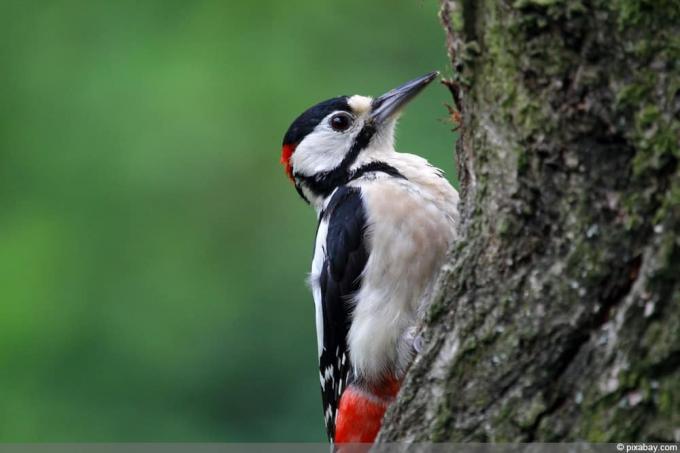
Table of contents
- Characteristics of Great Spotted Woodpecker
- Habitat of Great Spotted Woodpeckers
- garden as living space
- Food of the great spotted woodpecker
- The drumming
- flying and climbing skills
- The Brood Cave
- the breeding season
- The endangerment of the great spotted woodpecker
- Relatives from the woodpecker family
Birds usually delight us with their beautiful chirping. The woodpecker dances a little out of line. He tirelessly drums against tree trunks. Everyone has heard his drum roll at some point and clearly recognized him. But what does this bird look like? how does he live And what else does it like, apart from poking new holes in the trees with its beak?
Characteristics of Great Spotted Woodpecker
The great spotted woodpecker is a native bird that inhabits the forests in this country all year round. It owes its name to its appearance. Although its plumage is not really colorful with only three different colors, it is definitely more colorful than that of most other native birds. In some places it is also referred to as a tree chopper.
- Scientific name: Dendrocopos major
- Family: Woodpeckers
- Underside of body: off-white
- Upper side: black, with white patches on the shoulder
- Red nape patch on males
- Head: prominent, black and white, red-capped juveniles
- Claws: pointed and curved
- Body length: about 23 cm
- Weight: 60-90 grams
- Lifetime: approx. ten years
A notice:
The Great Spotted Woodpecker was voted Bird of the Year in 1997. His choice was representative of all the animals that were suffering from the decline of near-natural forests at the time.
Habitat of Great Spotted Woodpeckers
The woodpeckers are extremely adaptable birds, and their habitat is correspondingly large. With the exception of Australia and the very cold regions of the world, they are at home everywhere. Assuming trees grow there. In our latitudes, it is often found in dense mixed and deciduous forests. But light parks can also be inviting for him, provided they meet certain requirements. The great spotted woodpecker prefers areas in which it finds a lot of old and dead wood. This is ideal for his drum work. Wherever such wood is, he likes to settle down. Then it can be a park or even a house garden.
garden as living space
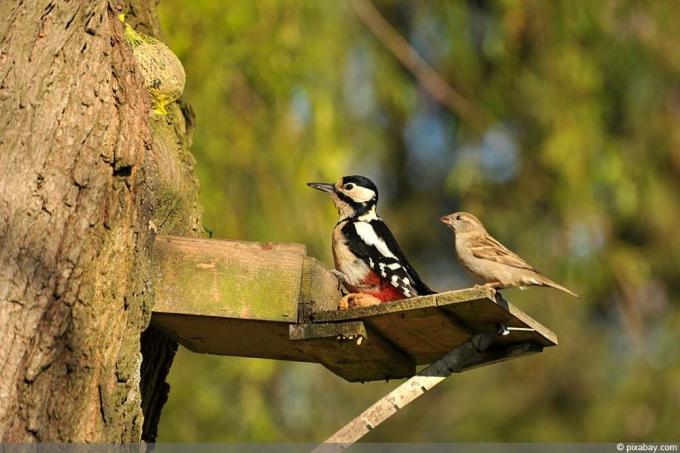
It is quite possible that a Great Spotted Woodpecker feels comfortable in a garden and chooses it as its habitat. If its regular drumming doesn't give you a headache, you can specifically attract this bird. Just offer him ideal living conditions. The chances are then good that the sporadic visitor will remain permanently.
- Do not remove dead branches immediately
- the great spotted woodpecker uses these to build burrows
- use no pesticides in the garden
- provide suitable food in winter
- e.g. B. fat balls, peanuts or sunflower seeds
- the suspended food should not swing freely
- a tree trunk rubbed with coconut oil lures him
Once you have attracted the great spotted woodpecker, you can now follow its fascinating spectacle.
Tip:
However, the great spotted woodpecker is also a gourmet who likes to nibble on cherries and strawberries. It is best to protect such fruits with a suitable net.
Food of the great spotted woodpecker
The great spotted woodpecker has a varied diet, so it never has to go hungry for long. He does not hate food and makes absolutely no distinction between animal and vegetable food. What is available is eaten.
- almost continuously: larvae and insects
- occasionally also eggs and young birds
- in winter mostly berries, cones, seeds and nuts
- additional sap in spring
The great spotted woodpecker gets the insects and larvae directly from the wood. First he hammers a hole in it with his beak. He then uses his tongue to pull the victim out of the hole. This works well because its tongue has barbs and is up to four centimeters long. The tip of the tongue is also coated with a sticky mucus and resembles a harpoon.
A notice:
Did you know that the great spotted woodpecker builds a so-called woodpecker smithy? If he can't find a suitable crevice in a tree, he'll hammer a hole in a branch with his beak. He clamps hard-shelled beetles in it so that he can then eat them more easily. The forge is also useful for cracking nuts.
The drumming
The typical drumming of the woodpecker is caused by the steady and rapid beating of its beak on wood. Again and again he hammers the wood 10-15 times for about two seconds. The "drumming" benefits him in several respects.
- for building caves
- to mark out the territory
- for communication, as a kind of language
- to attract a female
Although he hits the wood with full force several times, these impacts do not induce a headache. It has something like a silencer system. Its head and beak are not rigidly connected, but spring back. Thick bone covering of the brain and cartilage reinforcements are further protective mechanisms. And of course he always takes a break to rest and makes his work easier by using soft or soft material. rotten wood processed.
The woodpecker would rather drum than sing. However, if he senses danger, he will let out a loud 'kix'.
flying and climbing skills
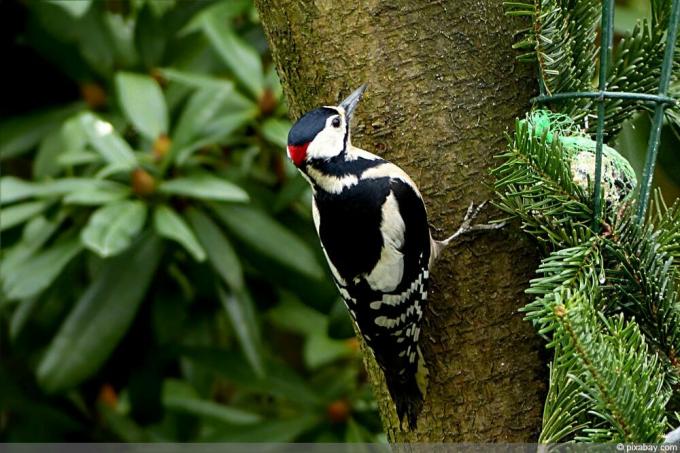
When the great spotted woodpecker is not drumming and instead flapping its wings, you can watch it doing its typical wave flight. He flaps his wings vigorously a few times and then pauses to glide. On the ground, he moves with jerky jumps that seem a bit awkward. Running does not seem to be its thing, but the great spotted woodpecker is a particularly good climber. He has to be, too, in order to be able to persevere in carpentry on his burrows. While banging on a branch with its beak, it needs a secure footing. Two parts of his body help him with this: the tail and the toes. Two of the toes point forward and two point backward. With its curved claws, it can hold onto the bark well. With the powerful tail, which is also known as a supporting tail, it can support itself on the trunk and thus achieve even more stability.
The Brood Cave
Great spotted woodpeckers do not build nests. It is a bird that breeds in caves. He has that in common with his other relatives who live here.
- he builds his cave himself
- usually he works several caves at the same time
- then decides on one which he completes
- soft woods are preferred
- as well as rotten trees
- construction takes about two weeks
A notice:
Great spotted woodpeckers can also cause damage in the vicinity of residential areas if they choose thermal insulation of buildings as a place for burrows.
the breeding season
The actual breeding season depends on where exactly it lives. The altitude and the associated climatic conditions determine the point in time.
- in the spring he goes in search of a suitable breeding ground
- at low altitudes already from the end of March
- after burrowing, around mid-April, egg-laying begins
- at high altitudes the breeding season begins about a month later
Although the great spotted woodpecker is so diligent in building dens, it usually only has one brood per year.
- four to seven eggs are laid
- incubation takes 10 to 13 days
- From the age of about 18 days, young birds are sighted at the flight hole
- after another 2-5 days they fly out
- are fed by the parents for another 8-10 days
A notice:
Young birds can be easily recognized by the red parting of their heads. Later only a red stripe remains on the back of the head.
The endangerment of the great spotted woodpecker
Fortunately, the great spotted woodpecker is not one of the endangered bird species. Due to its enormous adaptability, it has opened up a wide variety of habitats. In Germany alone, up to 500,000 breeding pairs were counted at times. However, it is important to know what makes the great spotted woodpecker's survival difficult in order for it to remain widespread in such large numbers. Its natural enemies are birds of prey, corvids and martens. But humans also interfere negatively in their living space. For example, when dead wood is removed from forests immediately and completely. However, this is important for the great spotted woodpecker. Careless use of pesticides can also affect this beautiful drummer.
Relatives from the woodpecker family
In the forests, the great spotted woodpecker is kept company by a number of relatives, including the green woodpecker, gray woodpecker and black woodpecker. As is usual with kinship, there are many similarities among these native woodpecker species. But there are also some differences.
green woodpecker
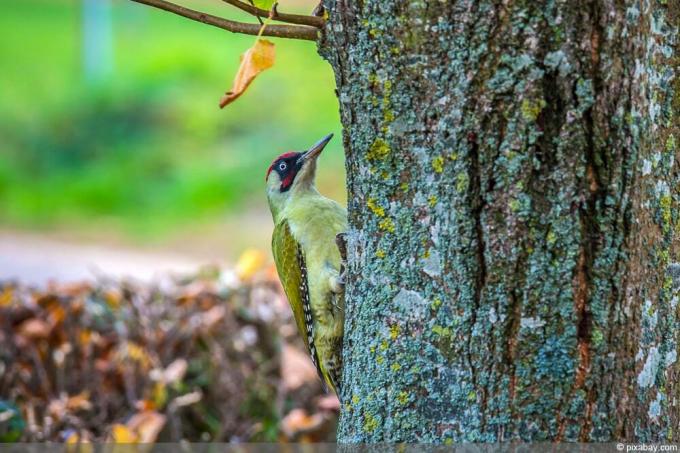
He is olive green with red markings on his head. In contrast to the great spotted woodpecker, it looks for its food mainly on the ground. Ant nests are its favorite search sites. He lets his unmistakable call sound relatively often.
gray woodpecker
Its head markings distinguish it well from the green woodpecker. While the male has a red front parting, the female is all gray at this point. They forage on the ground, just like green woodpeckers. In contrast to these, however, they drum much more frequently.
black woodpecker
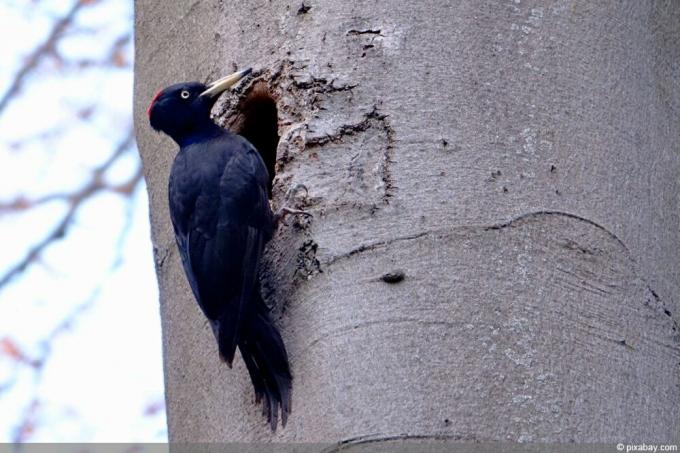
This species of woodpecker is the largest in Europe. It is easily recognized by its plumage color. Unlike the other woodpeckers, its flight is not wavy. He moves rather clumsily through the air, making loud noises.
Tip:
The calls of the woodpeckers differ from each other. If you are curious, you can search the internet for audio samples and listen.
 garden editorial
garden editorial I write about everything that interests me in my garden.
Learn more about breeding seasons
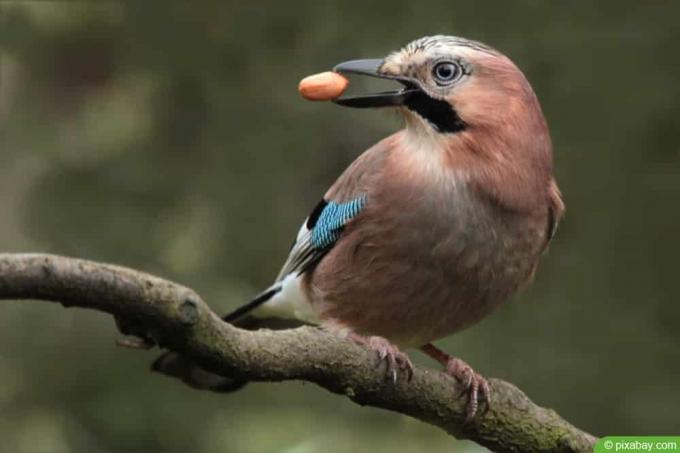
What does the jay eat? 5 Information about food & feed
As a relatively sedentary native bird, the jay always delights bird lovers with its visits. But in winter the animals, like many other birds, depend on our food supply. You can find out from us how and what you should ideally feed.

Blue tit, Parus caeruleus - profile, breeding season and food/food
One of the most striking songbird species is the blue tit. Her singing has a high recognition value. It is drawn to cities as well as to the countryside and its breeding behavior continues to promise a species of bird that is not threatened with extinction for the time being. Everything you should know about blue tits can be found in the Hausgarten-Journal.

Thrush, Turdus - profile, food, breeding season + difference to the blackbird
The thrush "Turdus", also known as the real thrush, comes from the thrush family and is one of the best-known and most widespread bird species in Europe. It has some differences to the blackbird and stands out due to certain behavioral patterns and characteristics. You can find out what the true thrush is and how it lives in the Hausgarten animal journal.
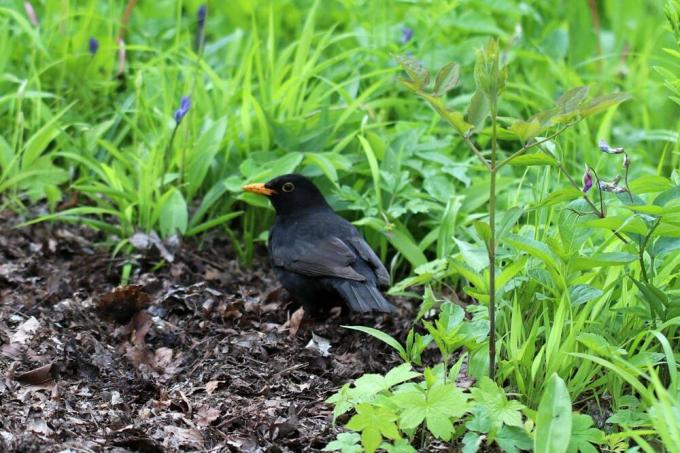
Blackbird, Turdus merula - profile, breeding season and food in winter
The blackbird "Turdus merula", also called black thrush, belongs to the thrush family. In Europe and especially in Germany, it is extremely widespread. It is not only because of its size that it stands out from the other thrush species. You can find out all the details of the Turdus merula from the home garden experts.

Wren – profile, breeding season and information about food
Such a loud voice is hardly to be expected from a small bird like the wren, making it a very special species of its species. Its singing fills entire gardens, bringing a touch of nature even to the densely populated city. In the home garden knowledge portal you can find out everything about the topic of wrens.

Robins - fact sheet with pictures, breeding season and food
The robin or Erithacus rubecula is a welcome guest in the garden. No wonder, because the communication between the birds is impressively versatile, the red-throated animals are useful in pest control and are simply pretty to look at. So many good reasons to welcome them to your own green.
